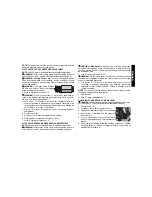
15
English
Code
Possible Cause
Possible Solution
1
Clogged or dirty inlet and or discharge line filter.
Clean or replace.
2
Lubricant viscosity too low
Drain existing lubricant and refill with D
E
WALT Synthetic
lubricant.
3
Lubricant viscosity too high
Drain existing lubricant and refill with D
E
WALT Synthetic
lubricant.
4
Lubricant level too low
Add lubricant to crankcase to proper level. Check for bearing
damage.
5
Detergent type lubricant being used
Drain existing lubricant and refill with D
E
WALT Synthetic
lubricant.
6
Extremely light duty cycles.
Run unit for longer duty cycles
7
Compressor check valve leaky, broken, carbonized or
Clean or replace as required. Inspect valves.
loose.
8
Carbon build up on top of piston
Clean piston. Repair or replace as required.
9
Piston rings damaged or worn (broken, rough, or scratched).
Install new rings.
Excessive end gap or side clearance. Piston rings not
seated, are stuck in grooves or end gaps not staggered.
10
Cylinder or piston scratched, worn, or scored.
Repair or replace as required.
11
Connecting rod, piston pin, or crankpin bearings worn or scored
Inspect all. Repair or replace as required.
12
Crankshaft seal worn or crankshaft scored
Replace seal or crankshaft assembly.
13
Extremely dusty atmosphere
Install more effective filtration or relocate unit.
14
Ambient temperature too low
Relocate unit to warmer environment. Ensure D
E
WALT synthetic
oil is in crankcase.
15
Worn cylinder finish
Degalze cylinder with 180 grit flex-hone.
16
Power cord not plugged in
Plug cord into grounded outlet.
17
Motor thermal overload switch has tripped.
Turn air compressor off, wait until motor is cool, then press motor
thermal overload button firmly until click is heard (located on
motor).
18
Fuse blown or circuit has tripped.
Replace fuse or reset circuit breaker. Check for proper fuse; only
“Fusetron” type T fuses are acceptable. Check for low voltage
conditions. Disconnect any other electrical appliances from
circuit or operate air compressor on its own branch circuit.
19
Wrong gauge wire or length of extension cord.
Check chart on page # 3 for proper gauge wire and cord length. If
possible, eliminate extension cord.
















































